Featured Comment:
“I made this last night with perfect Duroc pork chops. The marinade is super tasty and the reverse-sear is a game changer for me (and less dangerous for my hair…): before, I used a blow torch to get some final sear on miso marinated dishes. An awesome recipe!”
– Peti
How I Developed This Recipe
Pork and miso are undeniably a perfect pairing, but if you miss a few crucial details, miso-marinated pork can turn dry, bland, or scorched. I’ve tried various methods, meat cuts and timings, perfecting these details so you don’t have to. Today, I’m sharing a method you’ll rarely see, even in Japan.
Instead of using lean cuts, I start by choosing chops with bones or spare ribs just thick enough to stay juicy. Then, I use the “reverse searing” technique to cook the pork all the way through while preventing the miso from burning.
This dish truly captures the essence of my style, combining authentic Japanese flavors with unconventional approaches.
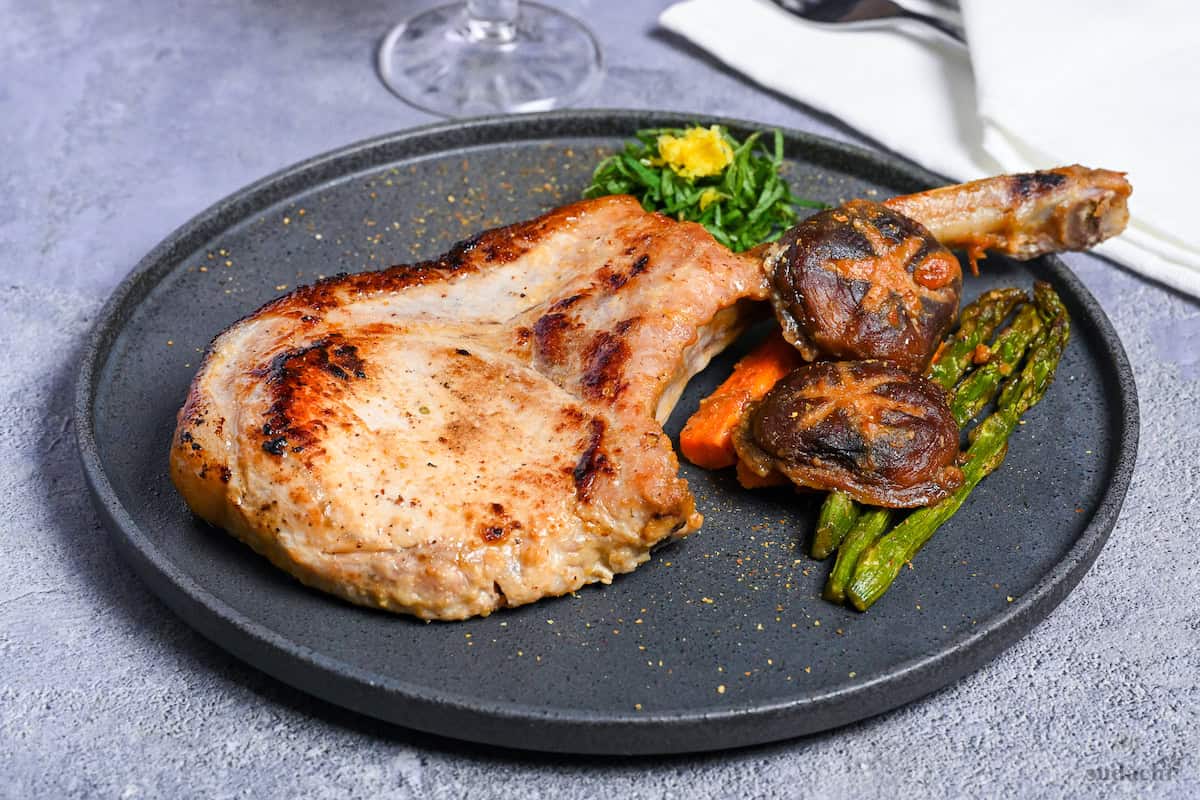
Choosing The Best Pork Cuts
When I was working on this recipe, I tried using different cuts of pork. Here are my conclusions.
| Cut | Flavor & Texture | Fit Rating |
|---|---|---|
| Bone-in Pork Chop | Balanced fat, built-in bone keeps meat juicy; classic “steak” bite | ★★★★★ |
| Spare Ribs | Rich porkiness and fork-tender meat | ★★★★★ |
| Shoulder Butt (Boston butt) | Marbled, bold flavor, forgiving to heat | ★★★★☆ |
| Pork Belly (thick-cut) | Ultra-rich, buttery fat that bastes itself, a little too fatty for this recipe | ★★★☆☆ |
| Tenderloin | Very lean, can dry out fast | ★★☆☆☆ |
First, the miso flavor goes really well with the sweetness and umami-rich fat of pork. That’s undeniable. Not only do lean cuts fail to achieve this flavor combination, but they also tend to be too dry. So I really don’t recommend them.
In the end, the best cuts I picked were bone-in chops and ribs, which are pretty unusual in Japan in general!
No matter which part you use, this recipe’s cooking time is designed for a thickness of about 2 cm.
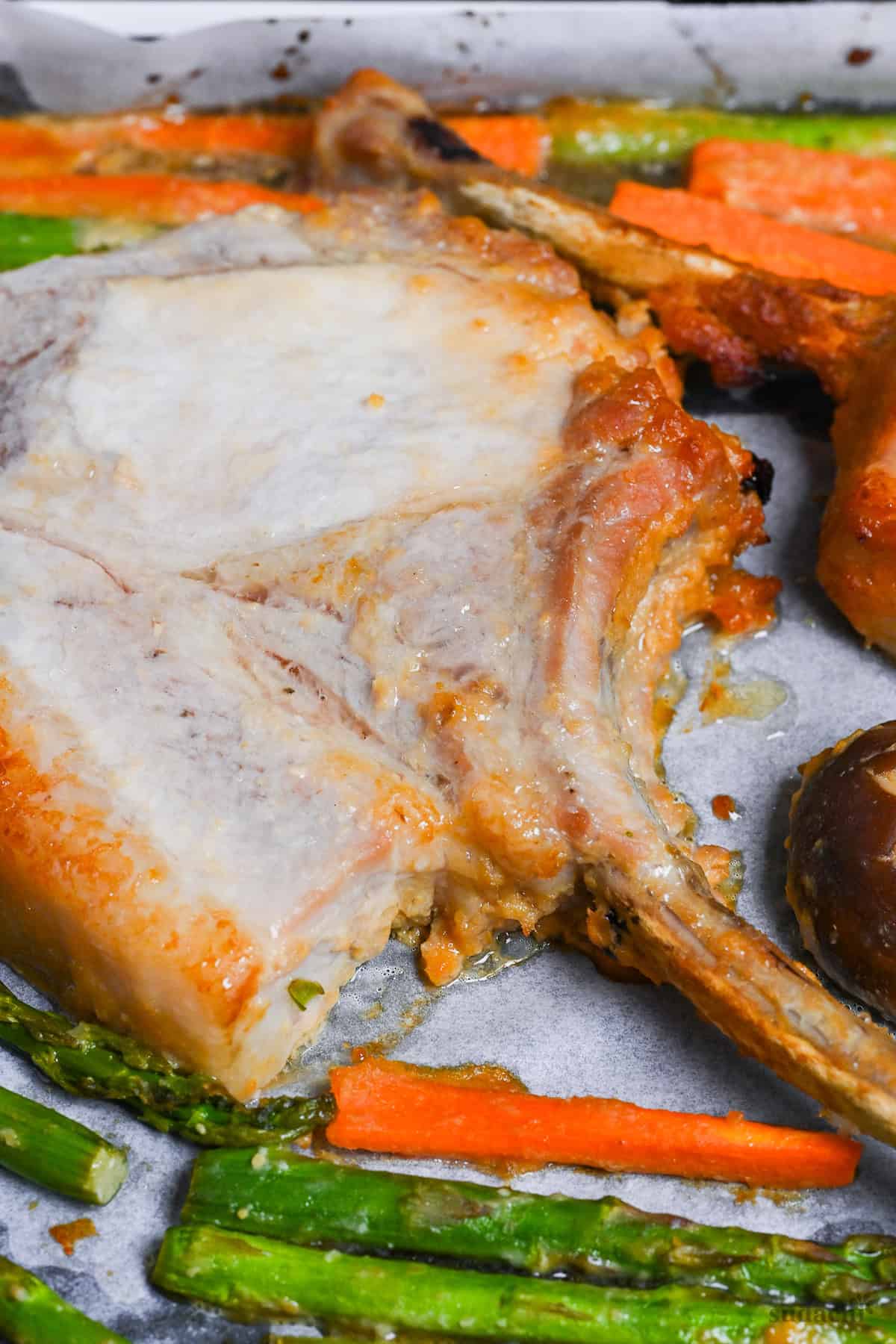
Visual Walkthrough & Tips
Here are my step-by-step instructions for how to make Miso Marinated Pork at home. For ingredient quantities and simplified instructions, scroll down for the Printable Recipe Card below.
If you prefer to watch the process in action, check out my YouTube video of this Miso Marinated Pork recipe for a complete visual walkthrough!
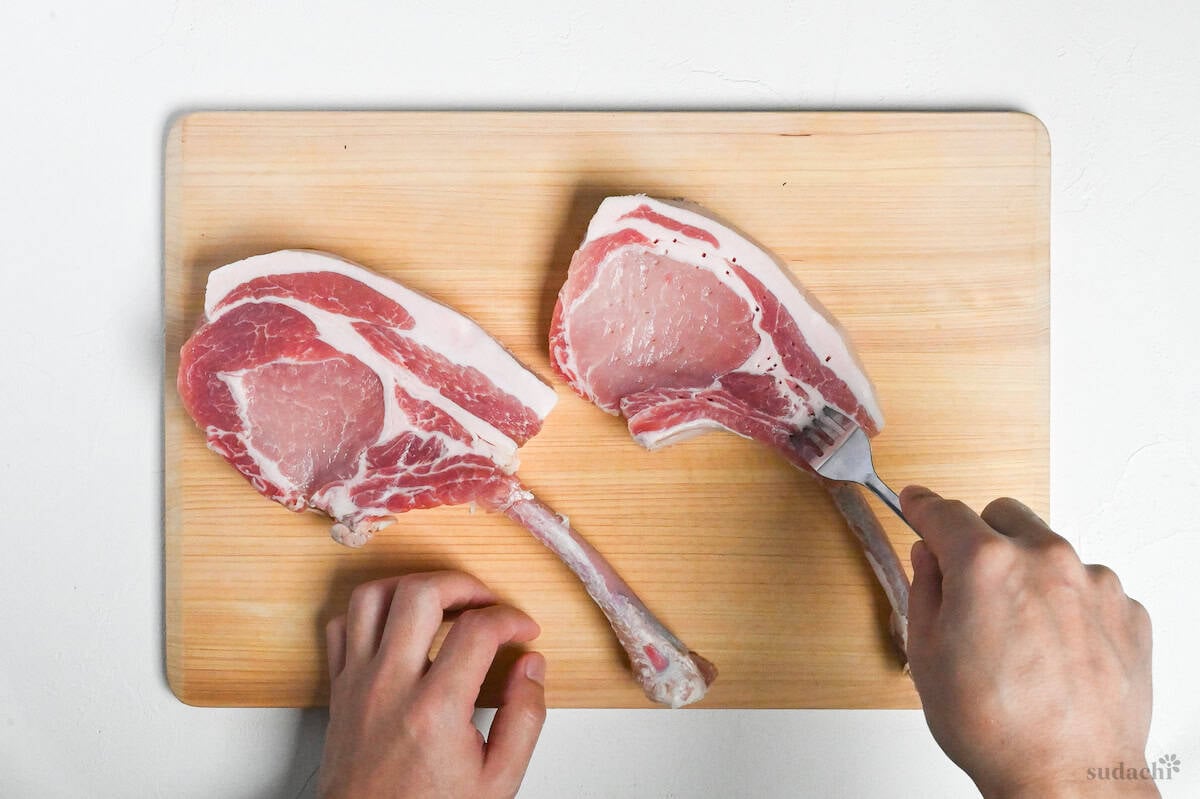
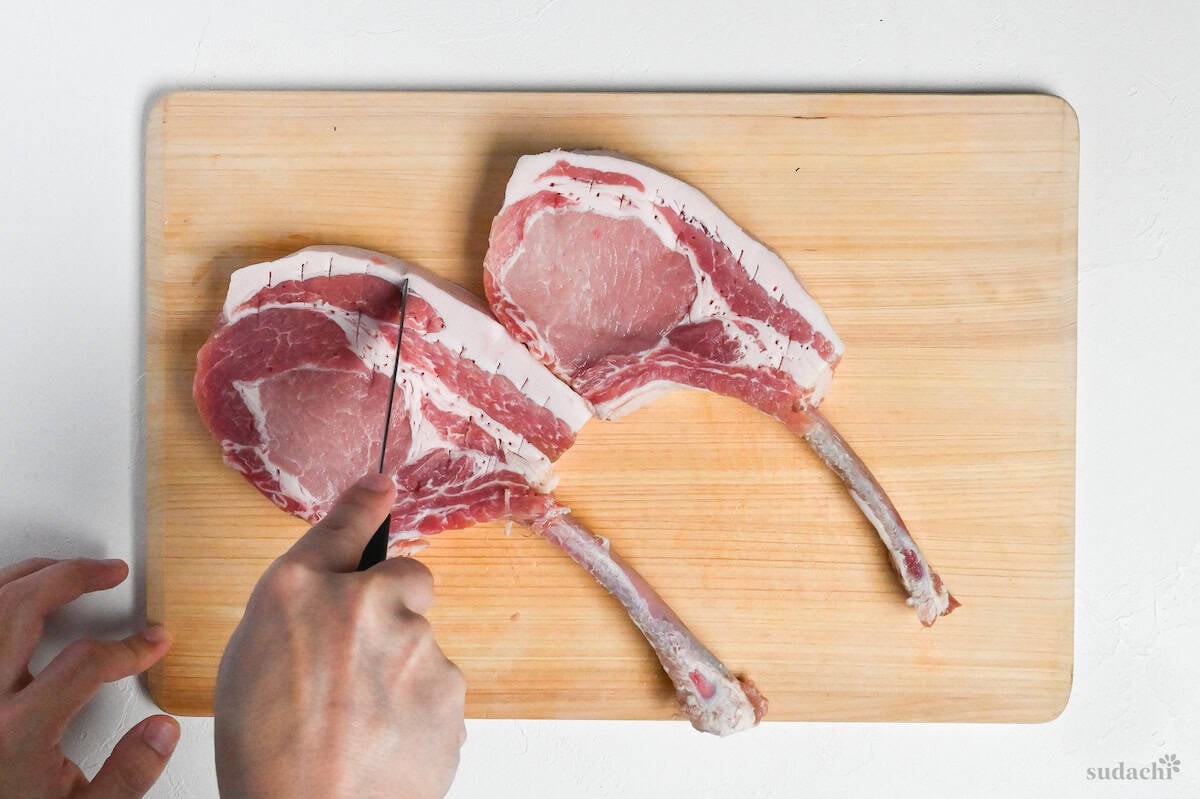
Pat the bone-in chops dry, then use a fork to pierce the surface every ½ inch on both sides. Give the fat edge a few extra pokes, then run the tip of your knife between the fat cap and the meat to snip any silver skin.
These tiny holes let salt and enzymes get straight into the muscle fibers, which speeds up flavor absorption and prevents the “curl” you get when intact connective tissue contracts under heat.
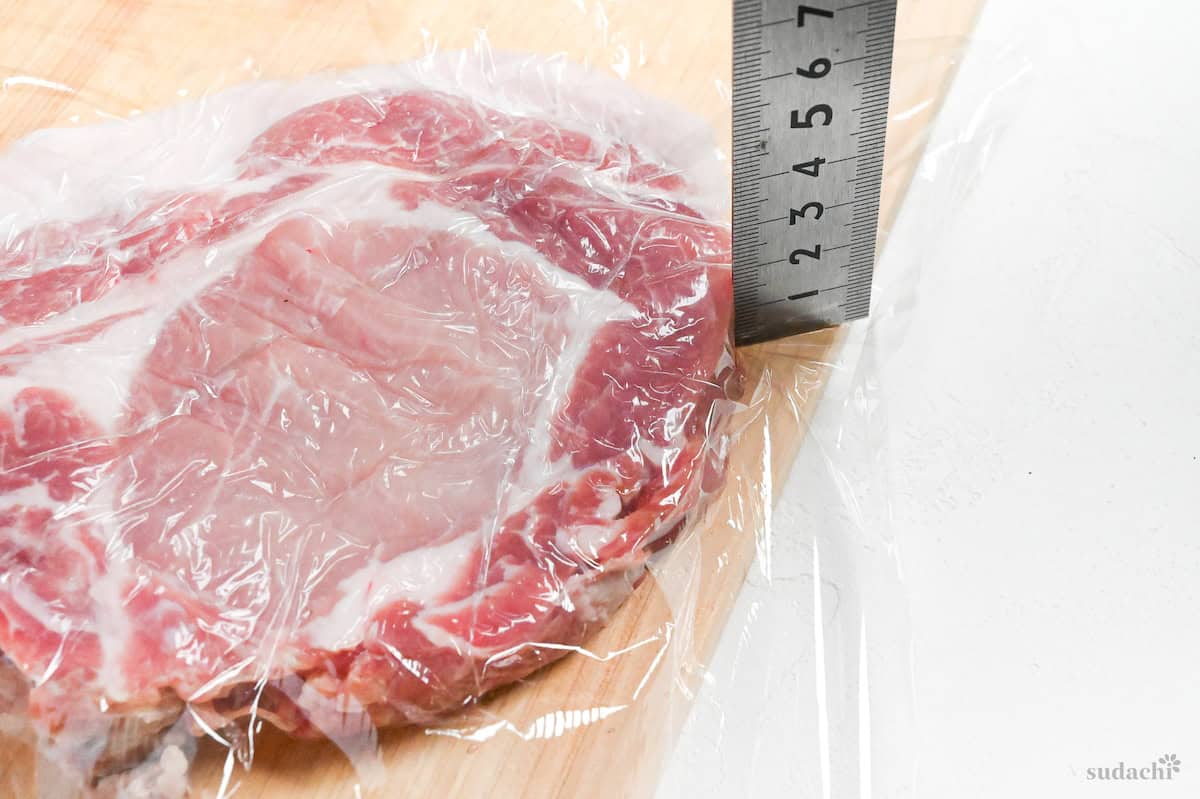
Pound the pork so that its thickness is approximately 2cm. This will tenderize it and help your pork pieces cook evenly.
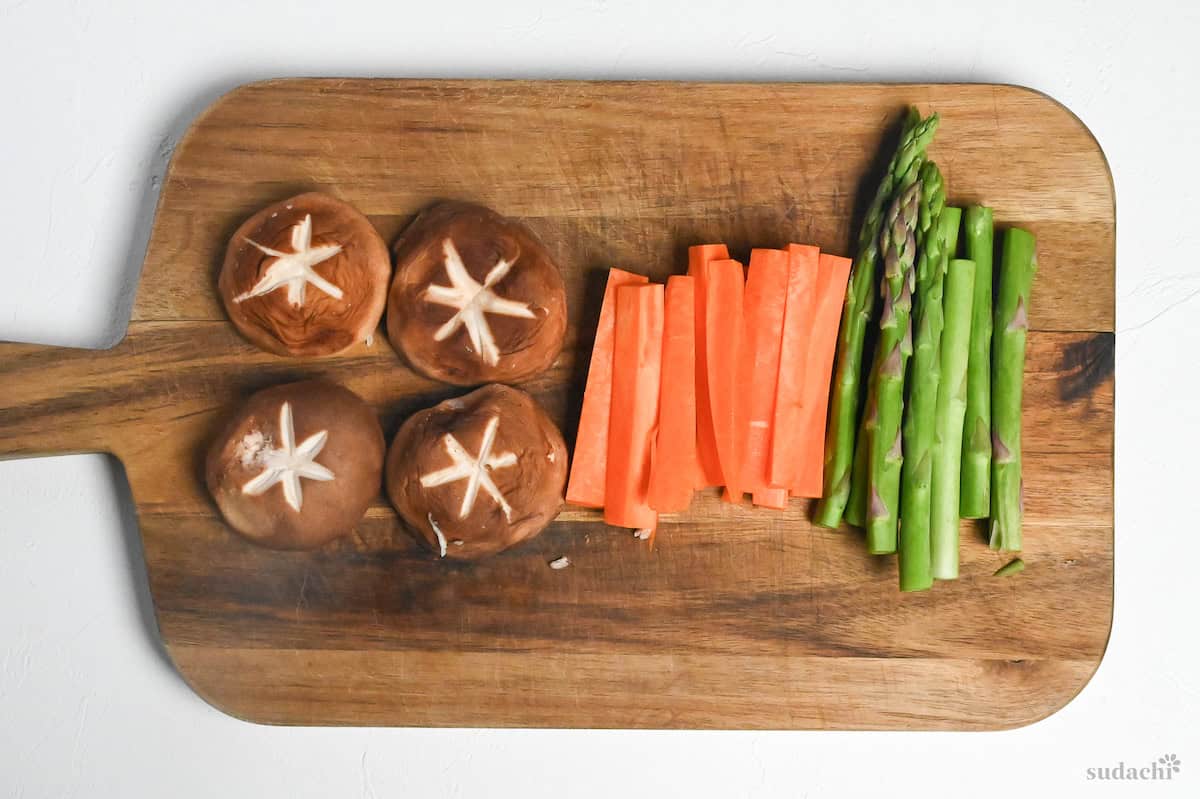
Halve the asparagus, cut the carrots into batons, and trim the stems of the shiitake mushrooms. I also like to cut a decorative star on the cap of the mushroom, but this is optional.
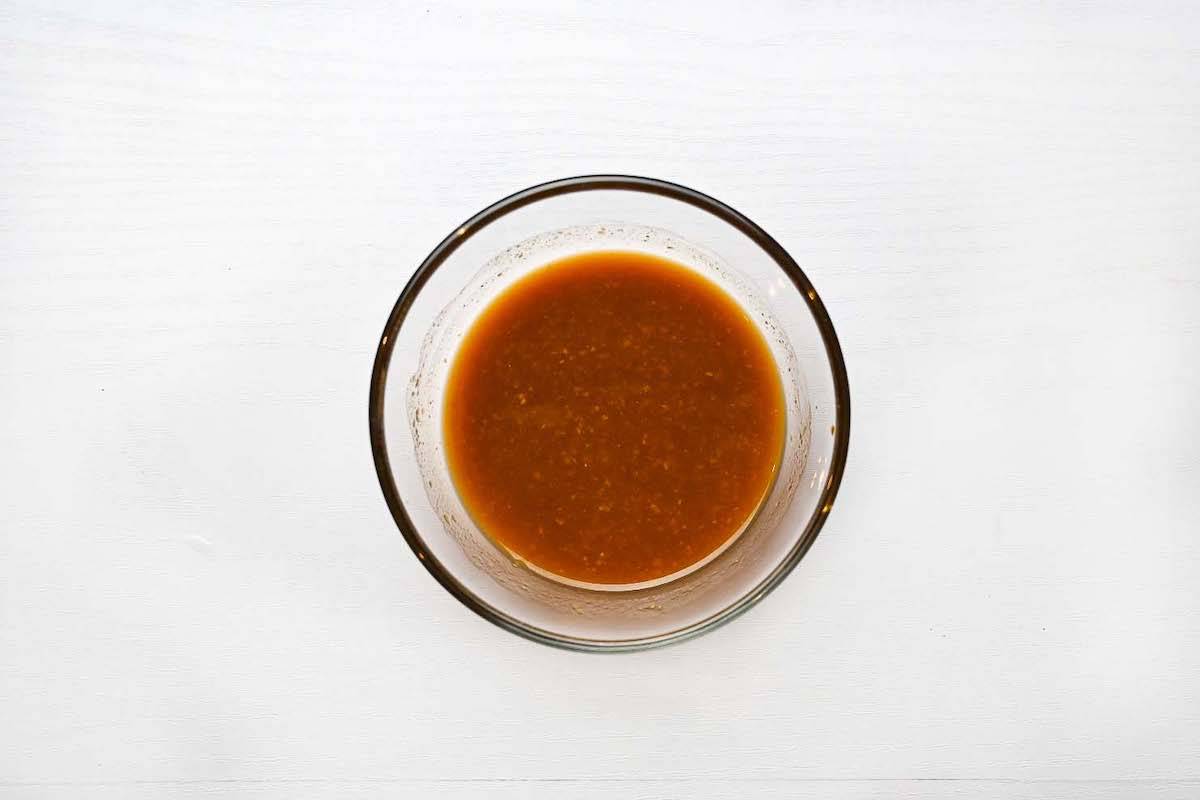
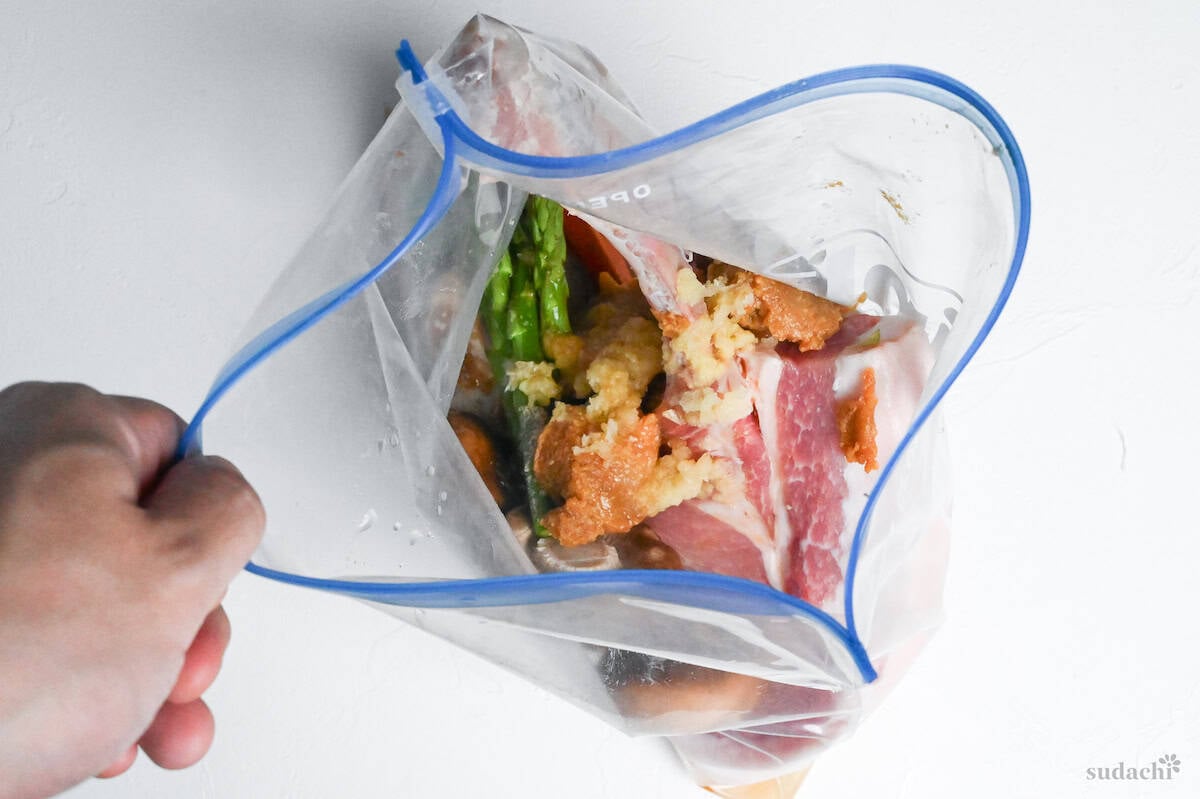
To make the marinade, whisk together awase miso, light brown sugar, sake, mirin, sesame oil, grated apple, ginger, garlic, and water beforehand until combined so that the marinade is attached to the ingredients evenly.
Scoop the chops, shiitake mushrooms, asparagus, and carrots into a zip-top bag with the marinade. Press out the air and massage until every nook is coated.
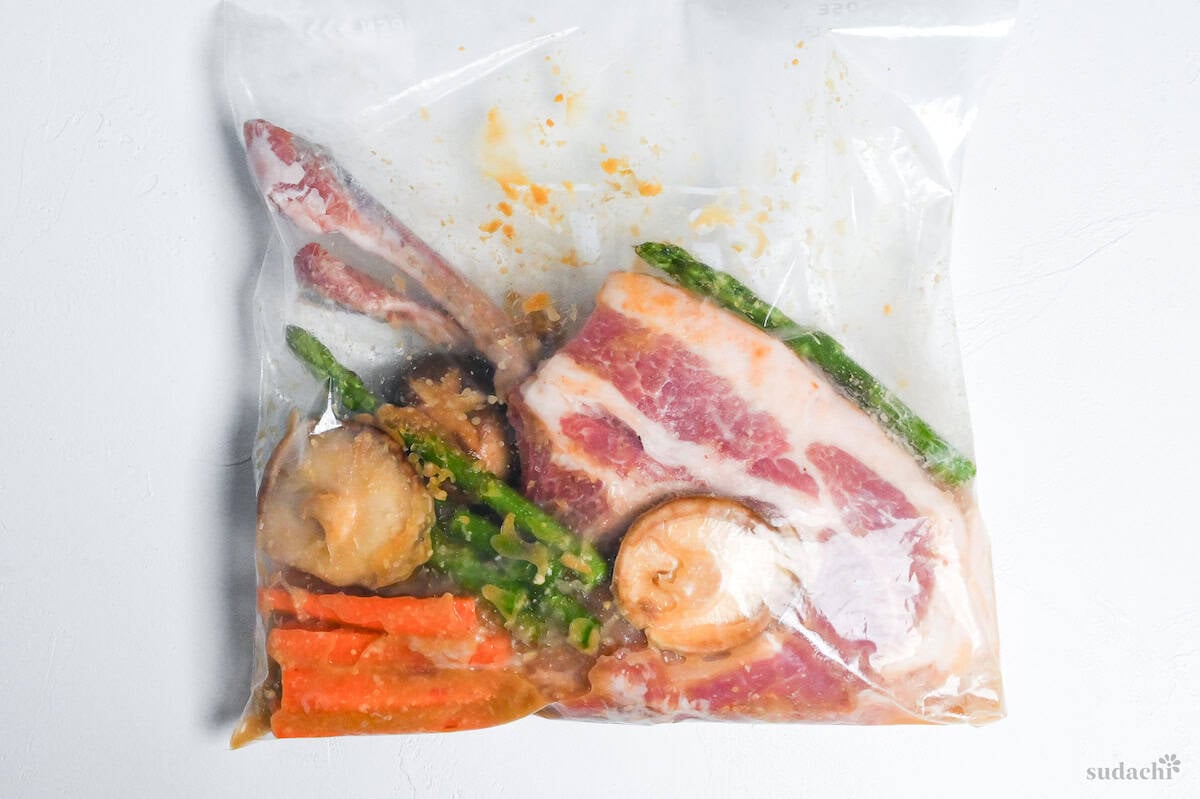
Lay the bag flat in the fridge for about 4 hours.
Apple’s malic acid plus ginger’s protease soften muscle fibers, while koji-based enzymes in miso tackle collagen!
Honey can stand in for sugar; grated pear for the apple; dry white wine or dry sherry for sake.
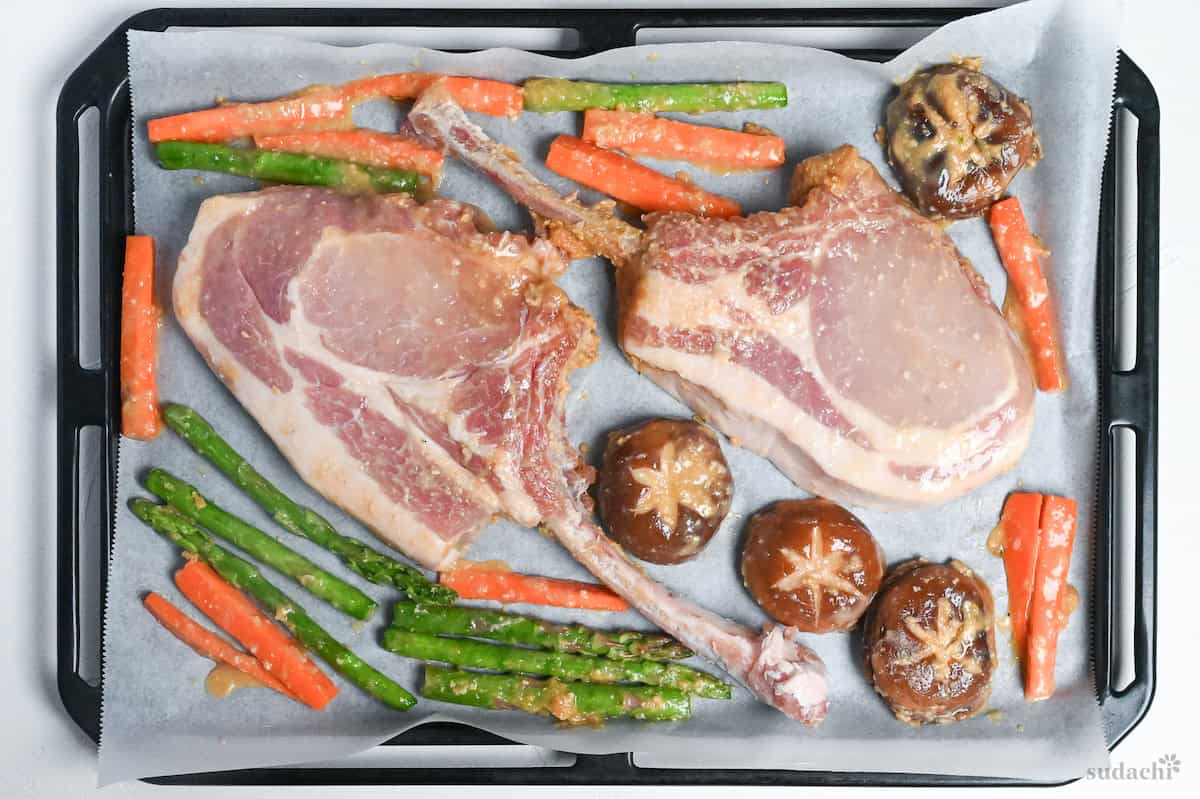
Line a sheet pan with parchment, lay the miso-marinated chops in the center, and scatter the shiitake, asparagus, and carrot sticks around them in a single layer.
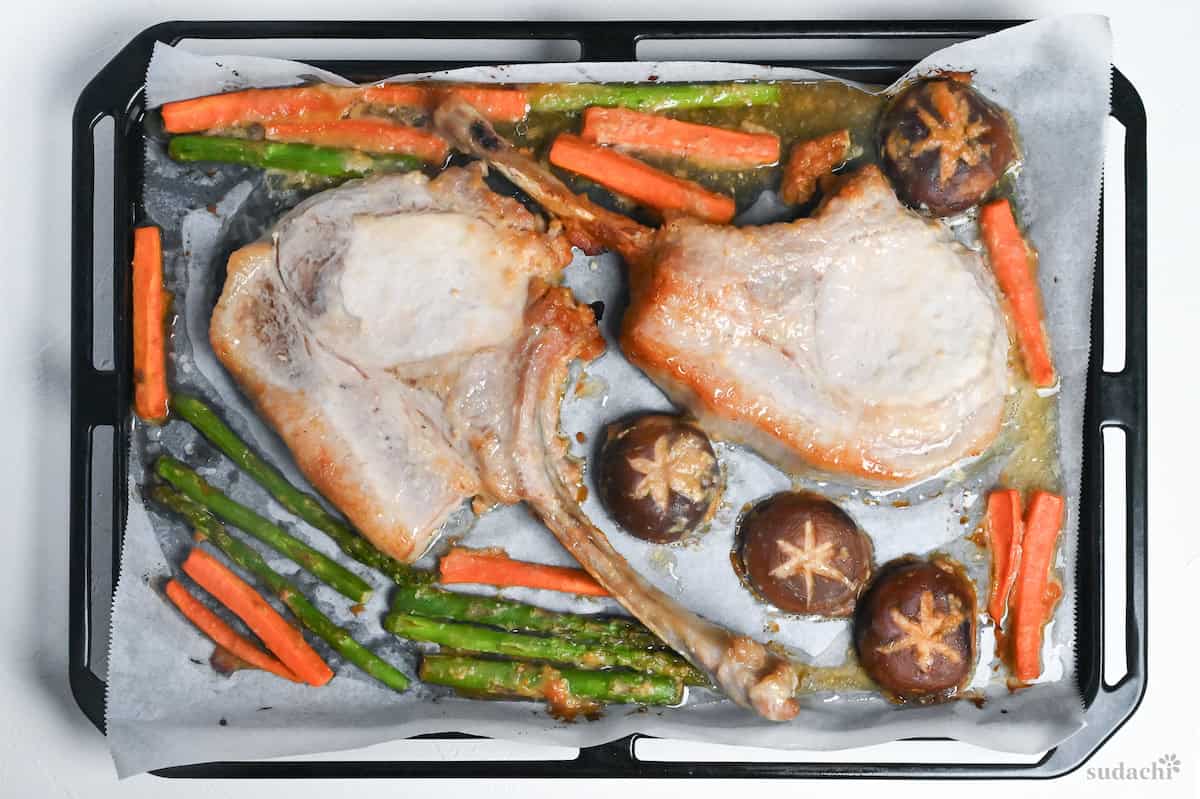
Slide the tray into a 250°F (120°C) oven and roast for 35 minutes. The vegetables will soften and start to pick up a light tan edge-perfect groundwork for the high-heat finish coming up next.
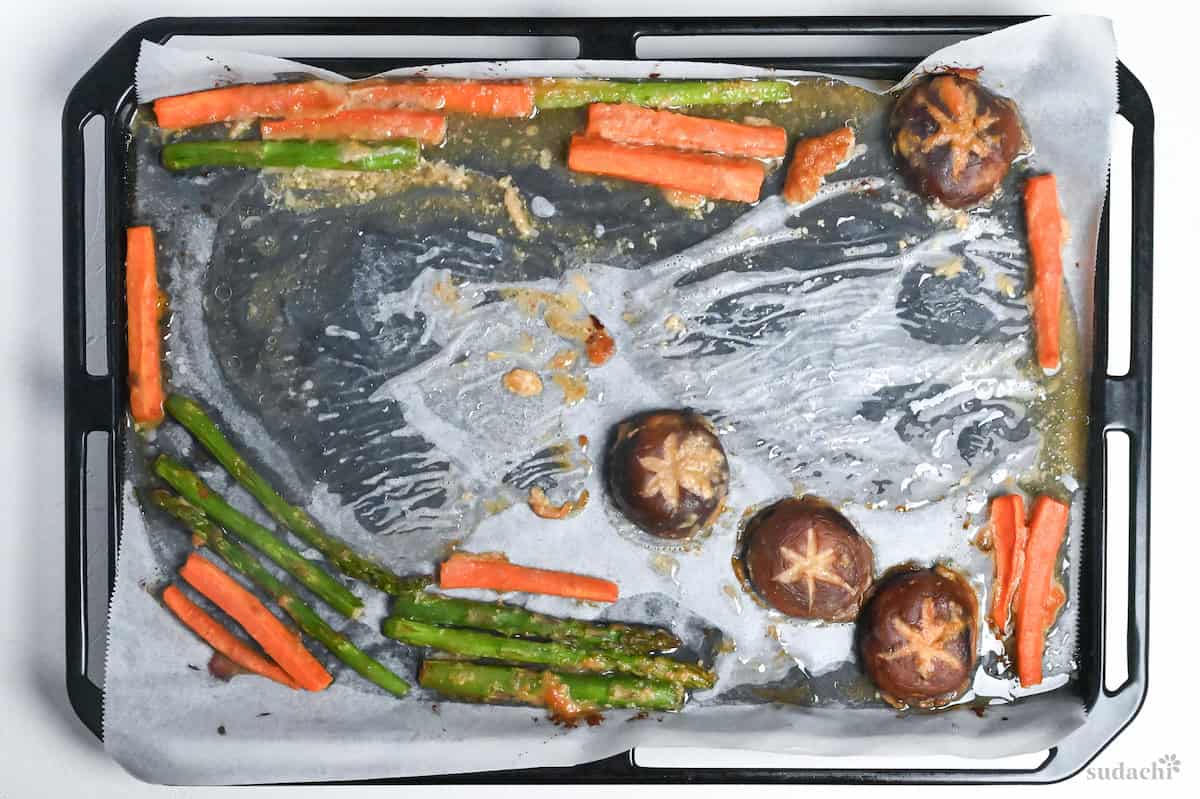
When the 35-minute roast is done, crank the oven up to 425°F / 220°C. While you wait for it to reach the higher temperature, you can sear the pork.
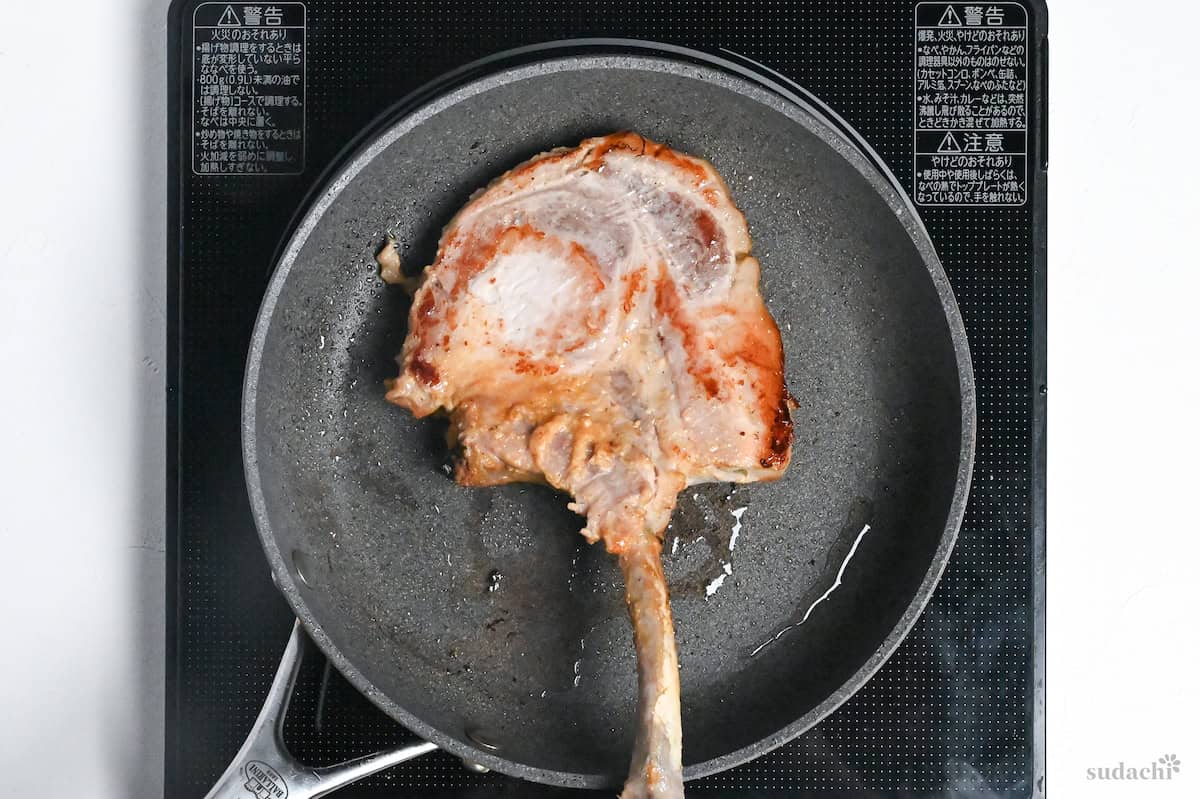
Pour some neutral oil into a large frying pan, then heat it over medium until it’s nice and hot. It’s important not to overcrowd the pan, so if you don’t have a large enough pan you can sear each pork chop individually like I did.
It’s important that the pan is preheated thoroughly, since we only want to brown the surface, not cook it any further.
Once the pan is fully heated, sear the first side for a full minute, flip, and sear the second side for another minute.
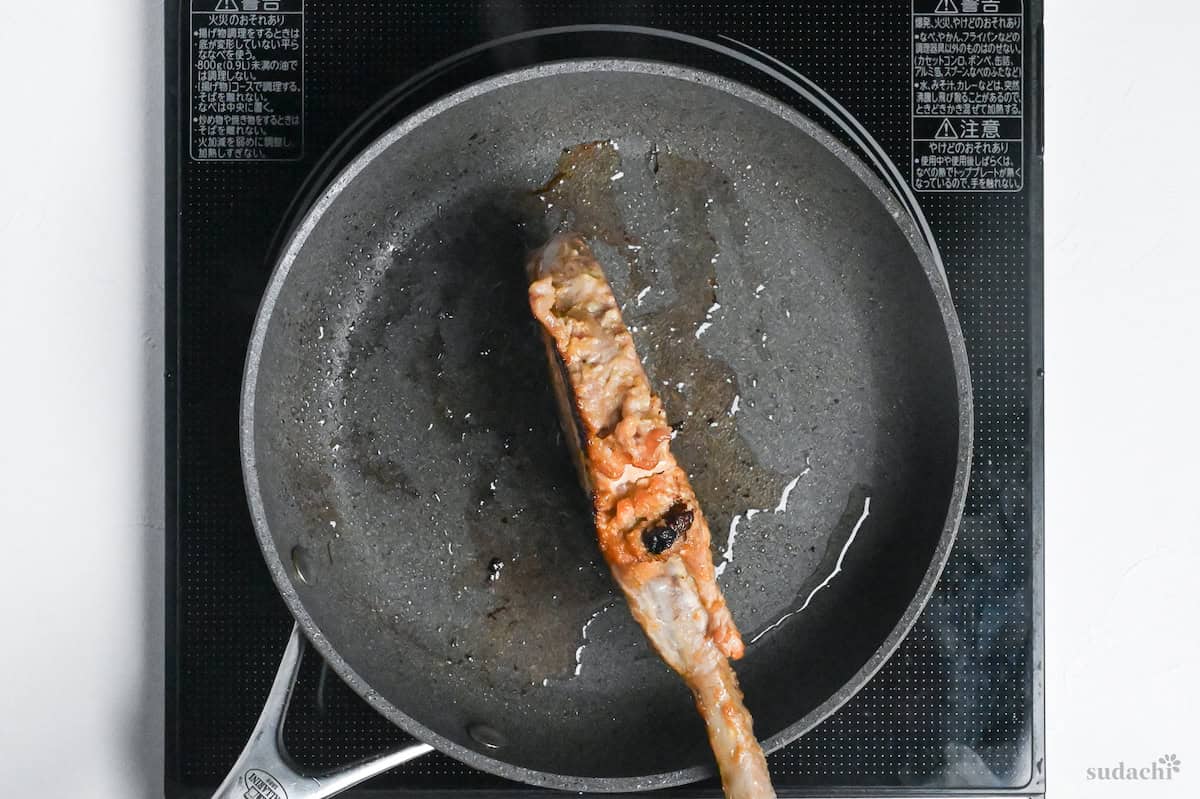
Finish by tipping the chop onto its side and sear the fat, rotating until the edges are nicely browned.
Roasting the chops first at a gentle 250°F / 120°C brings the interior up to a safe 145°F / 63°C without forcing out precious juices. Only after the center is perfect do we hit the skillet, so the sear can focus on browning. For more accurate results, you can use a meat thermometer to check the temperature and avoid under or overcooking.
The reverse-sear method lets the Maillard reaction and gentle caramelization happen in a controlled window, delivering a deep, nutty crust without the acrid char. Juicy center, crackly edge, zero drama.
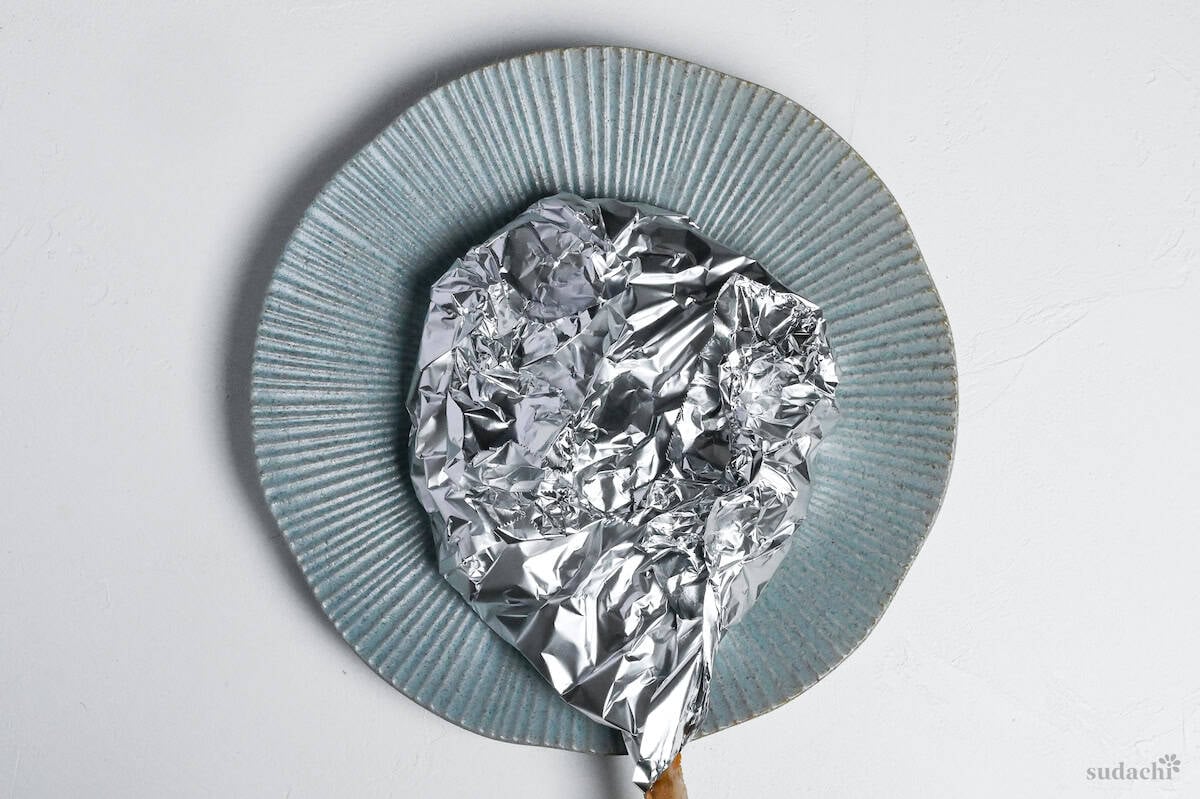
Transfer the chops to a plate and tent loosely with foil for 10 minutes. This short break evens out the internal temperature and lets the juices thicken and settle back into the meat.
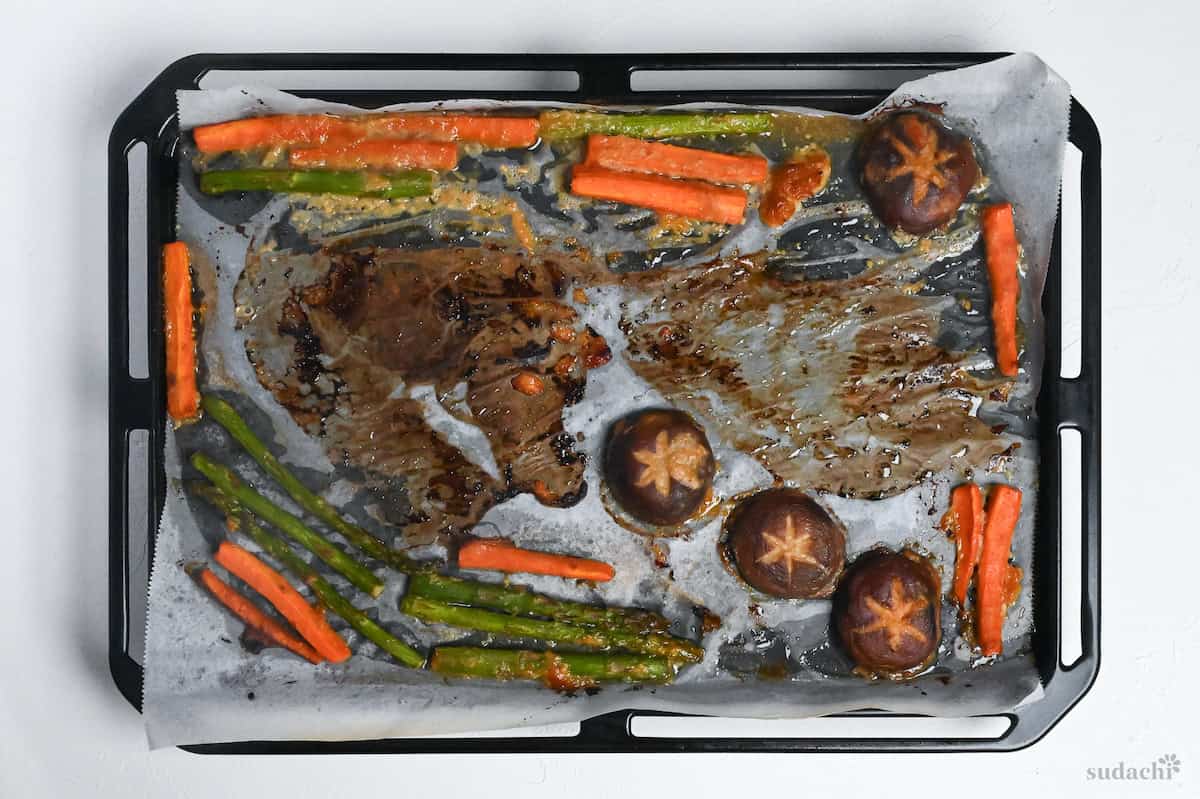
Your oven should (hopefully) be preheated by now, so return the tray of vegetables back to the oven for another 8-10 minutes until the shiitake caps blister, asparagus tips bronze, and carrot edges look candy-sweet.
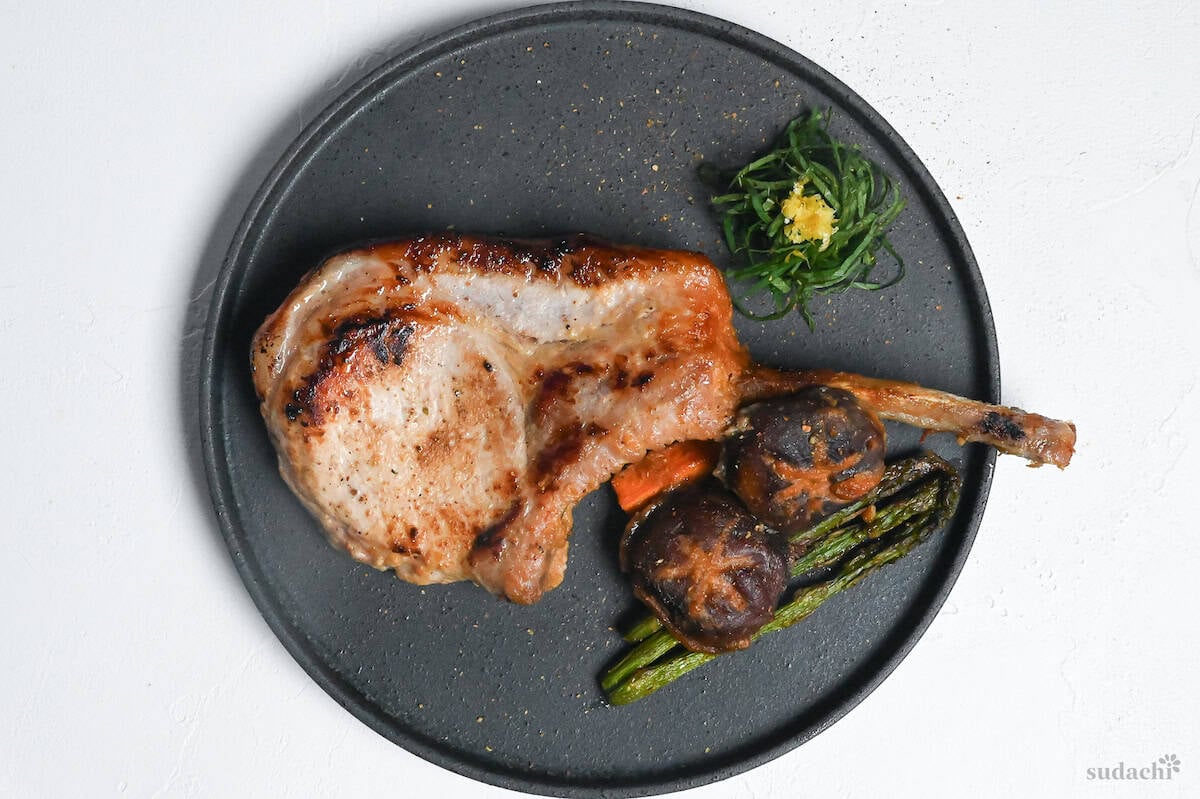
Unwrap the chops, put the roasted vegetables next to them, and add a finishing touch: shichimi for a little heat, a bit of yuzu zest for some brightness, or finely chopped shiso leaves for a fresh boost.
Other great toppings include toasted sesame, ground sansho, or any citrus zest you like.
Jump to Full Recipe MeasurementsEssential Tips & Tricks
- Choose bone-in pork chops, spare ribs, or well-marbled shoulder; lean cuts tend to dry out with this recipe.
- Pat the chops dry and pierce with a fork before marinating; moisture and intact fibers block flavor.
- Roast on parchment at 250°F / 120 °C until an instant-read thermometer hits 145°F / 63 °C in the center – this is the safe internal temperature for cooking pork.
- Preheat the pan thoroughly, then sear 1 minute per side over medium heat. Choosing medium heat (rather than high heat) browns the pork without burning the glaze.
- Rest the chops wrapped with foil for 10 minutes so the juices have time to redistribute into the meat.
- Crank the oven to 425°F / 220 °C for the final veg roast.
With these simple tips in mind, you’re set for success every time you make Miso Marinated Pork.
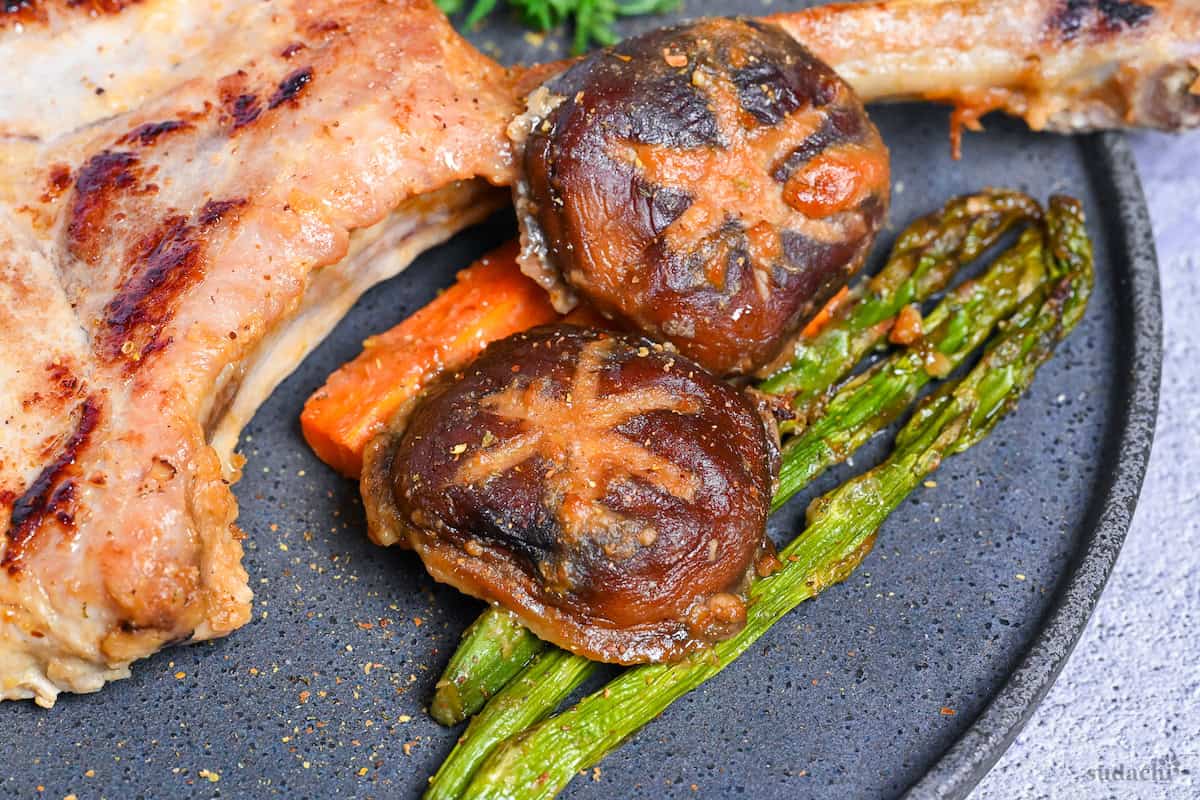
Meal Prep & Storage
This miso-marinated pork chop recipe is meal-prep friendly.
- Freezer Kit: After the 4-hour cure, wrap each chop (with a light smear of marinade) in plastic wrap, seal in a freezer bag, and freeze flat. Thaw overnight in the fridge and cook as written.
- Cooked-Ahead Option: Slow-roast the chops, cool quickly, and refrigerate. At mealtime, sear straight from the fridge to finish cooking.
- Storage Guide for Leftovers: Refrigerate fully cooked, cooled chops in an airtight container for 2-3 days. Freezing leftover cooked chops is possible, but not ideal, as the texture tends to toughen when reheated.
Serving Suggestions
FAQ
Here are answers to frequently asked questions I have received across all platforms, including here, YouTube, Instagram, and Pinterest. If you have any questions, feel free to send them to me anytime! It will be a big help for everyone in this community!
The technique dates back over a thousand years, when people packed fish-and later meat-in salty miso to keep it edible without refrigeration. By the Edo period, even shoguns received prized beef this way (miso marinated beef). Today we keep the tradition for flavor more than shelf life: miso’s enzymes tenderize the meat, while its salt and umami concentrate flavors during cooking.
Absolutely. White miso is sweeter and lower in salt, so reduce the brown sugar by about 25 % or plan on a sweeter crust. Red or mixed miso gives deeper, funkier notes.
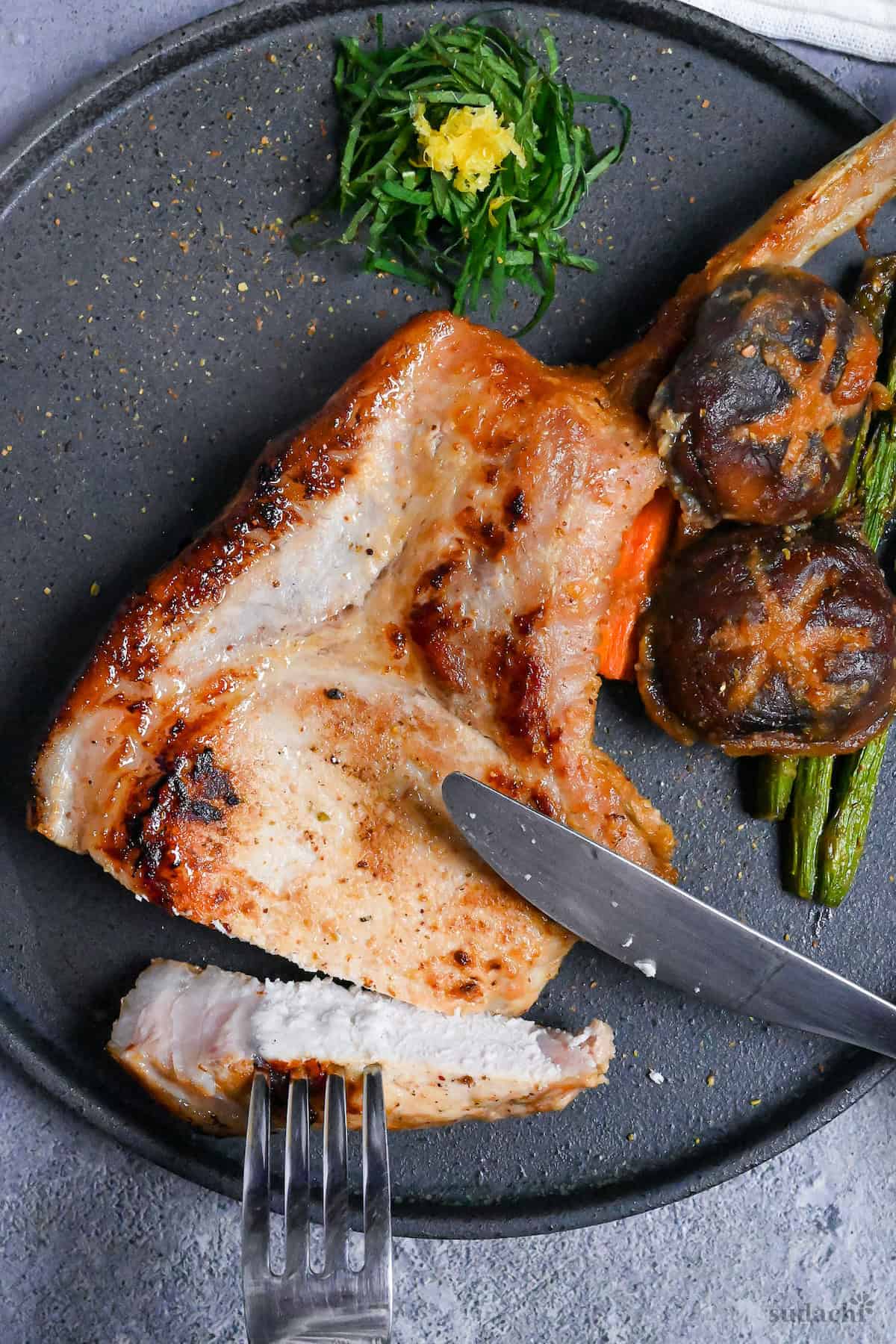
I hope you enjoy this Miso Marinated Pork recipe! If you try it out, I’d really appreciate it if you could spare a moment to let me know what you thought by giving a review and star rating in the comments below. It’s also helpful to share any adjustments you made to the recipe with our other readers. Thank you!
More Miso Recipes
- Pork Miso Ramen in 15 Minutes (Sapporo Style)
- Miso Glazed Salmon (Pan-fried)
- Simmered Miso Mackerel (Saba no Misoni)
- Nasu Dengaku (Grilled Eggplant with Miso Glaze)
Hungry for more? Explore my miso paste recipe collection to find your next favorite dishes!
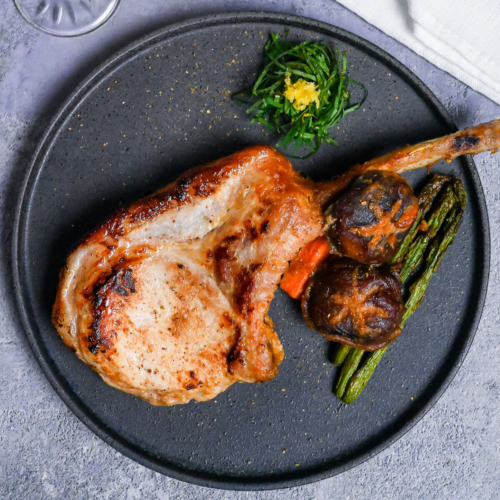
Miso Marinated Pork Chops
Ingredients
- 2 bone-in pork chops shoulder-butt steaks or single-bone spare ribs work too
- 4 fresh shiitake mushrooms stems removed
- 4 spears asparagus halved
- ½ carrot or baby carrots, cut into sticks similar size to asparagus
- ½ tbsp cooking oil neutral high-smoke point
- perilla leaves (shiso) shredded, optional garnish
- yuzu zest optional garnish
- Japanese chili powder (shichimi togarashi) optional garnish
Miso Marinade
- 3 tbsp yellow miso paste (awase) white/red blend
- 2 tbsp sake or dry sherry, dry white wine
- 1 tbsp light brown sugar or honey
- 1 tbsp grated apple or pear
- 1 tbsp water loosens paste
- 2 tsp toasted sesame oil
- 1 tsp mirin
- 1 tsp grated ginger root fresh or ginger paste
- 1 tsp grated garlic fresh or garlic paste
My recommended brands of ingredients and seasonings can be found in my Japanese pantry guide.
Can’t find certain Japanese ingredients? See my substitution guide here.
Instructions
- Take 2 bone-in pork chops and pat the surface dry with kitchen paper. Use a fork to pierce the meat all over (both sides), then use a sharp knife to make incisions on the fat.

- Lay the pork chops flat on a cutting board and cover them with plastic wrap, then pound until 2 cm (¾ inch) thick and place them in a sealable freezer bag.

- Break the woody stems off of 4 spears asparagus then cut them in half (or thirds). Remove the stems of 4 fresh shiitake mushrooms and cut ½ carrot into batons a similar thickness to the asparagus. Place all of the vegetables in the bag together with the pork.

- In a small bowl, mix 3 tbsp yellow miso paste (awase), 2 tbsp sake, 1 tbsp light brown sugar, 1 tbsp grated apple, 1 tbsp water, 2 tsp toasted sesame oil, 1 tsp mirin, 1 tsp grated ginger root, and 1 tsp grated garlic together until combined.

- Pour the marinade into the bag and massage until the pork and vegetables are evenly covered. Seal and marinate in the refrigerator for 4 hours.

- Preheat your oven to 120 °C (248 °F). While you wait, line a baking sheet with baking paper and arrange the pork and vegetables in a single layer without overlapping.

- Roast at the low temperature for about 35 minutes or until the pork reaches an internal temperature of 63 °C (145 °F).

- Take the tray out of the oven and increase the oven temperature to 220 °C (428 °F). Preheat a frying pan over medium heat with ½ tbsp cooking oil. Once the pan is fully preheated, sear the pork for 1 minute on each side.

- Hold each pork chop on its side to sear the fat on the edges, turning until browned all the way around.

- Wrap each pork chop with foil and rest for 10 minutes on a warm plate.

- While the pork is resting, return the baking tray with the vegetables to the preheated oven and bake at 220 °C (428 °F) for 8-10 minutes.

- Plate up and garnish with shredded perilla leaves (shiso), yuzu zest and a sprinkle of Japanese chili powder (shichimi togarashi). Enjoy!

Video
Notes
- Make sure to pound the pork until about 2 cm thick (≈ ¾ inch) so the low-temp roast and one-minute sear cooks it through evenly.
- Pat the meat dry and pierce every ½ inch with a fork so the miso cure reaches the center fast.
- Roast the veg in the oven at a higher temperature (425°F / 220°C) they’ll blister while the meat is resting.
- Use a meat thermometer for more consistent results. The safe internal temperature for pork is 145°F / 63 °C.
- Don’t skip resting the pork in foil, this will help the juices thicken and redistribute into the meat making it juicier and more tender.
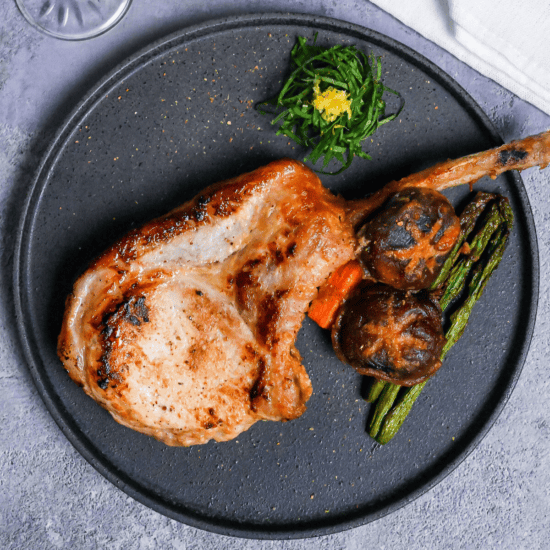




Given that in Japan it is near impossible to get pork bone-in, what do you recommend instead?
Hi Ellie,
Thank you for your question! I’ve had luck finding bone-in pork at places like Ropia and sometimes AEON, but availability really varies by location and branch. If it’s hard to find, I recommend using pork shoulder/butt (豚肩ロース). I’ve tried this recipe with this and it has a great balance of flavor and tenderness. If you can get it as a block, slicing it to match the thickness of bone-in chops that I used works really well. On the other hand, I’d avoid using loin (豚ロース), as it gets too dry with this recipe (I also tested it). They have very similar names in Japanese so be sure to pick the one has “肩” on the label!
Hope that helps!
Yuto
I tried it with ribs instead, seriously good!
Thank you, Bella!
I made this last night with perfect Duroc pork chops, yamitsuki cabbage as the side. The marinade is super tasty and the reverse-sear is a game changer for me (and less dangerous for my hair…): before, I used a blow torch to get some final sear on miso marinated dishes. An awesome recipe!
Hi Peti,
Thank you so much for trying this new recipe! I’m happy to hear that yo enjoy it! And I’m glad the reverse sear saved your hair from the blowtorch adventures!
Yuto